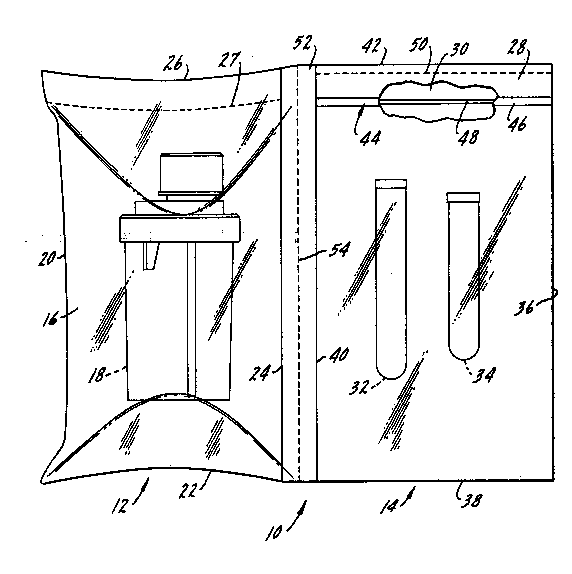Some of the information on this Web page has been provided by external sources. The Government of Canada is not responsible for the accuracy, reliability or currency of the information supplied by external sources. Users wishing to rely upon this information should consult directly with the source of the information. Content provided by external sources is not subject to official languages, privacy and accessibility requirements.
Any discrepancies in the text and image of the Claims and Abstract are due to differing posting times. Text of the Claims and Abstract are posted:
| (12) Patent: | (11) CA 2124701 |
|---|---|
| (54) English Title: | DUAL POCKET PACKAGE |
| (54) French Title: | EMBALLAGE A DOUBLE POCHE |
| Status: | Term Expired - Post Grant Beyond Limit |
| (51) International Patent Classification (IPC): |
|
|---|---|
| (72) Inventors : |
|
| (73) Owners : |
|
| (71) Applicants : |
|
| (74) Agent: | MARKS & CLERK |
| (74) Associate agent: | |
| (45) Issued: | 1997-02-25 |
| (22) Filed Date: | 1994-05-31 |
| (41) Open to Public Inspection: | 1994-12-30 |
| Examination requested: | 1996-03-08 |
| Availability of licence: | N/A |
| Dedicated to the Public: | N/A |
| (25) Language of filing: | English |
| Patent Cooperation Treaty (PCT): | No |
|---|
| (30) Application Priority Data: | ||||||
|---|---|---|---|---|---|---|
|
A specimen collection kit particularly for collection and transport of urine specimens. The kit includes a first pouch sealed about its periphery and encapsulating a collection container therewithin. A second pouch is provided, also with a peripheral seal, and encapsulating one or more test vials for specimen testing. The second pouch also includes a resealable seal proximate one edge such that the second pouch can be resealed after opening of the peripheral seal on that edge. The pouches are united along one edge of each pouch, and a perforation is provided at that juncture to permit severing of the two pouches.
Une trousse de prélèvement d'échantillons particulièrement destinée pour le prélèvement et le transport d'échantillons d'urine. La trousse comprend une première poche scellée sur sa périphérie et renferme un conteneur de prélèvement. Une seconde poche est fournie, également munie d'un dispositif de scellement périphérique et renfermant un ou plusieurs flacons de test pour un test d'échantillon. La deuxième poche comprend également un dispositif de scellement refermable à proximité d'un bord de manière à pouvoir sceller de nouveau la deuxième poche après ouverture du dispositif de scellement périphérique sur ce bord. Les poches sont reliées le long d'un bord de chaque poche, et des perforations sont appliquées sur cette jointure pour permettre la séparation des deux poches.
Note: Claims are shown in the official language in which they were submitted.
Note: Descriptions are shown in the official language in which they were submitted.

2024-08-01:As part of the Next Generation Patents (NGP) transition, the Canadian Patents Database (CPD) now contains a more detailed Event History, which replicates the Event Log of our new back-office solution.
Please note that "Inactive:" events refers to events no longer in use in our new back-office solution.
For a clearer understanding of the status of the application/patent presented on this page, the site Disclaimer , as well as the definitions for Patent , Event History , Maintenance Fee and Payment History should be consulted.
| Description | Date |
|---|---|
| Inactive: Expired (new Act pat) | 2014-05-31 |
| Inactive: IPC from MCD | 2006-03-11 |
| Inactive: IPC from MCD | 2006-03-11 |
| Letter Sent | 2001-05-17 |
| Grant by Issuance | 1997-02-25 |
| Request for Examination Requirements Determined Compliant | 1996-03-08 |
| All Requirements for Examination Determined Compliant | 1996-03-08 |
| Application Published (Open to Public Inspection) | 1994-12-30 |
There is no abandonment history.
| Fee Type | Anniversary Year | Due Date | Paid Date |
|---|---|---|---|
| MF (patent, 4th anniv.) - standard | 1998-06-01 | 1998-02-12 | |
| MF (patent, 5th anniv.) - standard | 1999-05-31 | 1999-04-28 | |
| MF (patent, 6th anniv.) - standard | 2000-05-31 | 2000-05-17 | |
| MF (patent, 7th anniv.) - standard | 2001-05-31 | 2001-02-27 | |
| MF (patent, 8th anniv.) - standard | 2002-05-31 | 2001-05-03 | |
| MF (patent, 9th anniv.) - standard | 2003-06-02 | 2003-05-02 | |
| MF (patent, 10th anniv.) - standard | 2004-05-31 | 2004-05-04 | |
| MF (patent, 11th anniv.) - standard | 2005-05-31 | 2005-05-04 | |
| MF (patent, 12th anniv.) - standard | 2006-05-31 | 2006-05-01 | |
| MF (patent, 13th anniv.) - standard | 2007-05-31 | 2007-04-30 | |
| MF (patent, 14th anniv.) - standard | 2008-06-02 | 2008-04-30 | |
| MF (patent, 15th anniv.) - standard | 2009-06-01 | 2009-04-30 | |
| MF (patent, 16th anniv.) - standard | 2010-05-31 | 2010-04-30 | |
| MF (patent, 17th anniv.) - standard | 2011-05-31 | 2011-05-02 | |
| MF (patent, 18th anniv.) - standard | 2012-05-31 | 2012-04-30 | |
| MF (patent, 19th anniv.) - standard | 2013-05-31 | 2013-04-30 |
Note: Records showing the ownership history in alphabetical order.
| Current Owners on Record |
|---|
| SAGE PRODUCTS, INC. |
| Past Owners on Record |
|---|
| DONALD R. HARRELD |
| JANET RATAJCZAK |
| PAUL H. HANIFL |